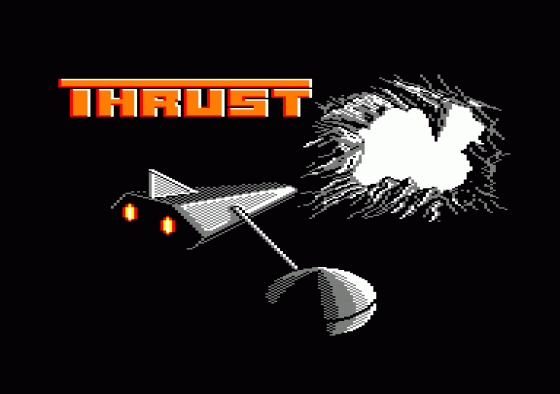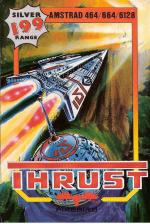
Amstrad Computer User
 1st October 1986
1st October 1986
Categories: Review: Software
Publisher: Firebird
Machine: Amstrad CPC464/664/6128
Published in Amstrad Computer User #23
Thrust
Every game these days seems to need a 50 word plot. Does Space Invaders have a plot? Does chess? Of course not, and they seem none the worse.
So let's get Thrust's theatricals out of the way. The resistance is planning a grand attack on the Intergalactic Empire, and to this end have snaffled some starships. Unfortunately, they appear to be missing certain vital components, to wit, Klystron Pods. In the real world, klystrons are three element vacuum tube microwave oscillators, now largely superseded in low power applications by Gunn diodes - that'll impress your friends.
These pods are kept on supply planets and are protected by nuclear-powered limpet guns. Obviously the Empire is expecting an attack by radioactive shellfish. Instead they get... guess who. I thought you'd be pleased. Anyway, your task is to go in, grab the pods and escape to deep space.

To disable the guns you must fire at the atomic stations that provide the oomph. Too much, however, and the reactor goes critical. This results in the total destruction of the planet some ten seconds later. And you were worried about Chernobyl.
This worldwide wipeout, can be either a Bad Thing, if you haven't got the pod, or a Good Thing, if you have. In fact, there are bonuses for escaping a user-induced cataclysm carrying a klystron.
And that's just about that. In rasterised reality, you're guiding an Asteriod-style spaceship, built out of lines instead of being a solid sprite, over a bleak landscape. Gravity is a major factor, and you've got to actively and precisely use the ship's thruster to prevent yourself crashing into the ground.

Your ship also has an unhealthy helping of inertia, so unless you balance out each manoeuvre in a Newtonian manner you'll find yourself spread over the surface in no uncertain terms. Of course, you have a gun to shoot things with, and a tractor beam/shield. This performs three functions - it protects you from gunfire, makes the connection between you and the pod, and allows you to tap the fuel stores that are scattered here and there.
At first, the pods lie lightly defended on the surface, but as you progress they get hidden in more and more tortuously twisted caverns. And then things get really nasty. There are doors that slam shut, and reverse gravity which can make tootling down the Al27 on a moped in the rush hour seem like driving a model train.
And there's something even more deadly waiting in the wings, but describing it would spoil the surprise. [This means he can't get further than the reverse gravity, but he can read the inlay card - Ed]

Once you've got the pod in tow it makes handling the ship much more difficult, and if the pod gets hit by a gun or bashed against a rock - easily done - then the ensuing extirpation does you no good at all. Assuming you escape unhindered from these hazards with your pod, then you're free - free to try the next, more devious, route to ruin.
Nigel
After a solid weekend of playing Thrust I am still addicted. Now that may not sound very much but when you have 20 games a month to play it is easy to be fickle and fl it from game to game.
Anything which keeps me playing at four in the morning has to be good. When you first start to play each new screen looks impossible but you rapidly acquire the skills to get through it.

Thrust is a game where you learn by doing.
Liz
Simple and addictive, two of the elements which make a super game. Piloting an asteroids type ship - rotate left, rotate right thrust and fire - is a skill which most ancient arcade addicts have to a tee.
The game on which Thrust is based is Gravita, which featured deep space battle sequences and was a shade more complicated. Once you have mastered the control everything changes, reverse gravity is a swine. Disappearing landscapes are worse.

Thrust passes the "just one more game" test with flying colours.
Colin
Firebird seems to be a little indiscriminate in its effort to grab the budget market. In the same month that the abysmal Helichopper abased the Arnold. Thrust thrilled this keytapper.
Taking a simple theme or two (Moon Lander, Asteroids and Gravita), Thrust proves that you don't need whizzo graphics or zillions of windows to produce a demanding and enjoyable game.
Maybe it's that the game always needs a little bit more skill and precision than you're capable of just now, but you've just got to keep playing. The lack of a joystick option deserves a raspberry.
Other Reviews Of Thrust For The Amstrad CPC464/664/6128
Thrust (Firebird)
A review by Bob Wade (Amstrad Action)



